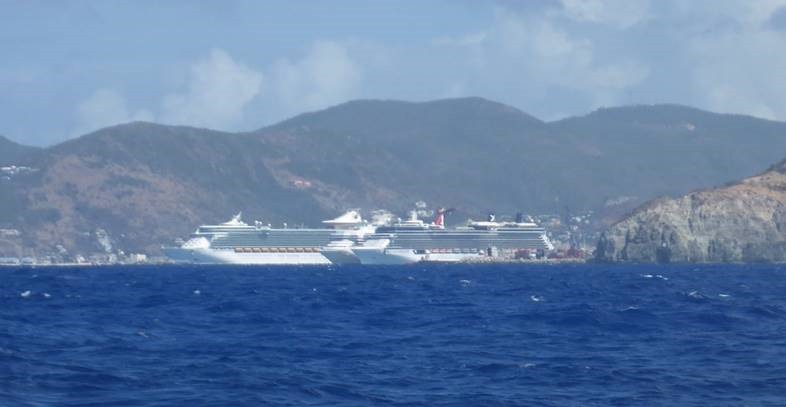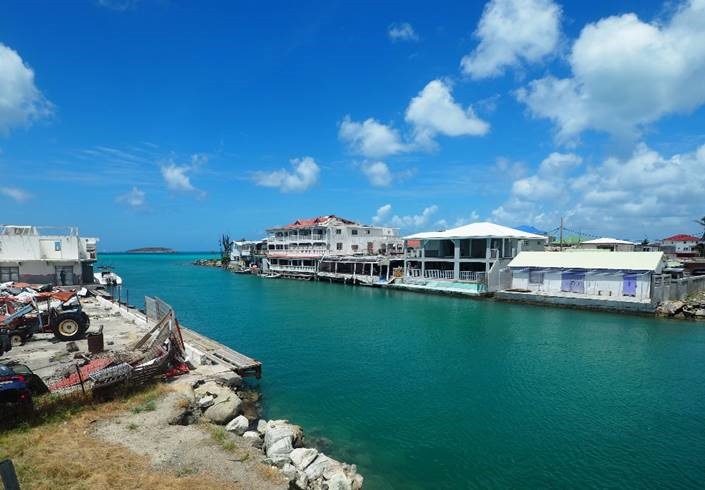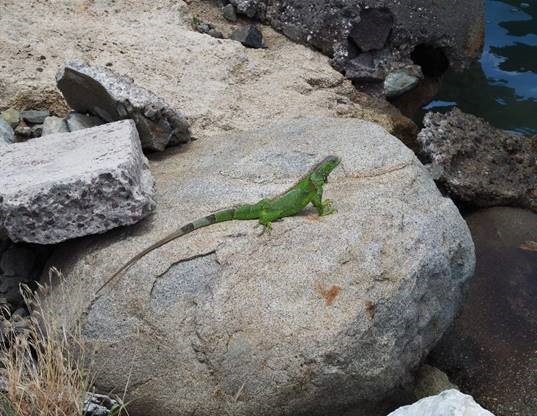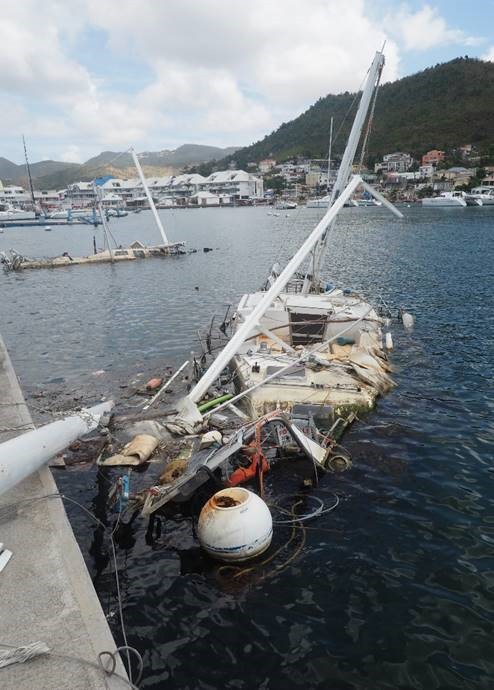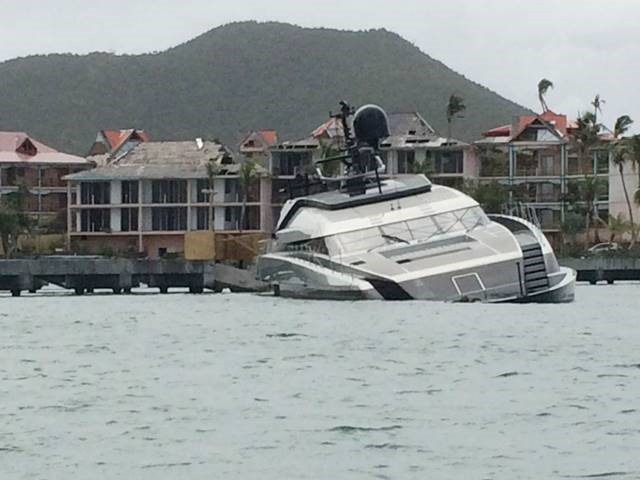24 March - St Martin - split personality?

|
18:04.2N 063:05.6W We could have stayed longer at Montserrat to do some walking, but we had seen the ‘main attraction’ (the volcano) and whilst parts of the island are very beautiful, the relocation of the population has undermined some of that and it did not seem as spectacular as Dominica or St Lucia for hiking. There are no long sandy beaches and the town is underwhelming. So we left Montserrat after supper that evening for the 80 mile passage up to St Martin, a unusual island in that it is jointly owned by France and the Netherlands. We passed along the east coasts of St Kitts and Nevis during the night. I was surprised by the amount of street lighting, given that the harbours are on the west coast and we wondered if we had missed a trick by skirting past without visiting. The pilot book and the Lonely Planet didn’t sell them well enough. Similarly, we left St Barthelemy to starboard; it’s known as a playground for the rich and famous and you could see a number of superyachts anchored there. Perhaps we should aim to visit these places when we return south to the Caribbean in the winter?
Dutch Sint Maarten is open for business! We had a fast, enjoyable reach in fairly heavy seas up to St Martin/Sint Maarten and arrived off the Dutch half of the island around lunchtime. There were three large cruise ships in the port at Philipsburg and the seafront looked busy. It didn’t look very Caribbean – more Mediterranean with large hotel developments – but the beaches looked splendid, if rather too cluttered with holidaymakers. We were headed for Marigot Bay on the French side, so followed the coast round the western tip of the island, under the flight path of a steady stream of executive jets into the Queen Juliana airport, famously built on the beach. The French side looked deserted. Long stretches of stunning beach, backed by smaller, more discrete resorts, but with obvious signs of hurricane damage (they were badly hit by Irma in early September 2017). As we turned the corner and beat up into Marigot Bay, the damage to buildings and foreshore was immediately apparent. Plenty of rooves off, windows missing, paintwork ‘sandblasted’ by wind, salt water and flying debris, ferro-cement sea walls crushed, palm trees at crazy angles.
Trashed and abandoned resort in French St Martin Marigot Bay is quite shallow and lies north of a huge area of water known as Simpson’s Lagoon which is accessible through a couple of man-made ‘cuts’ in the sand dunes. We found good holding roughly equidistant between the town of Marigot and the lagoon entrance at Sandy Ground and got our heads down. The following morning we took the dinghy into Port Louis Marina, an entirely man-made extension to a small bluff, to clear Customs. The French system is unusually straightforward in the Caribbean – no carbon paper copies or repeated information for different authorities, just a ‘one stop’ DIY computer terminal.
Boat envy in Marigot Bay I had a good chat with the young lady in reception. There’s a sense of a ‘rite of passage’ about surviving a hurricane of this magnitude and she was quite dismissive of Dominica’s troubles, claiming that St Martin had the worst of it – and no help from the French Government. She was quite upbeat and glad to tell her story. I was reminded of conversations on Montserrat and in Dominica about who ‘had it worst’. The marina was functioning, with about 40% of the berths occupied, a number of sunken craft still entangled in the structure and some piers still wrecked. The outer wall was damaged, but not breached. Ashore, 20% of the buildings had serious damage, 80% still needed tidying up. There were surprising bits of debris lying about – the removal of a wooden pallet resting half way up a stone sculpture was clearly not a priority, but I felt like stepping up and doing it myself because it was such an obvious thing to do to make a statement about ‘pride of ownership’. 10% of the cars had windows missing, but the roads were clear and the overhead powerlines all in place. The Europeans seemed slightly dazed and disinterested, the Africans were doing the work. I had a strong sense of a lack of leadership and an expectation that the Government would provide. Clearly it wasn’t…
The canal into Simpson’s Lagoon, Shrimpy’s has the orange roof. Otherwise a mix of abandoned structures and reconstruction. Note the three iguanas in the bottom left of the photo.
Close-up of the leader of the pack. We got back in the rubber boat and set off for Simpson’s Lagoon and the Dutch side. The foreshore looked like a war zone, admittedly without bullet holes and reminded me of run down villages in Yemen. Apartment blocks with the top floors abandoned to the elements, but people eking out an existence nearer ground level. Beach debris encroaching further inshore as Nature reverses Man’s feeble attempts at land reclamation. In the canal there is a well-known restaurant/storage/laundry/one stop shop called Shrimpy’s. We called in to see if they would do our laundry. The business is run by an elderly South African and his wife, who were sitting in near darkness surrounded by outboard motors in various stages of dis-assembly and an Aladdin’s Cave of boating stuff. The business was functioning, the laundry working, but I didn’t feel particularly welcome – I think they were exhausted. The lifting bridge across the canal was unlikely to reopen in the next month or so – you could see the control boxes smashed open and exposed to the elements. Beyond it, we entered a huge boatyard area. There was quite a bit of activity: some boats being prepared for sea in the normal course; some undergoing significant repairs following near-catastrophic hurricane damage; broken masts everywhere; and a number of very sad looking craft coloured light brown. On closer inspection, this was marine growth: they had clearly been submerged for several weeks before being dragged ashore. As we emerged into the lagoon itself, we saw a vast expanse of marine graveyard. There were some yachts, in commission and undamaged – clearly visitors like ourselves who had entered the lagoon through the Dutch side – but most of the moorings were occupied by damaged boats. Most of these had no masts and guardrails carried away, but otherwise largely intact. There were other boats, mainly motor cruisers, lying on the seabed with just the cabin tops above the waves. In the mangroves around the shore, more boats, some the classic low-end ‘liveaboard’, others flung there by the hurricane. And a couple of large commercial vessels which had been abandoned long before Hurricane Irma.
Wrecks in Simpson’s Lagoon, near Port Royal Marina We motored south under a smart roadbridge and into the Dutch part of the island. More money evident here: a series of boutique marinas with superyachts alongside, more commercial activity ashore, more obvious signs of reconstruction than the French side. Collections of badly damaged large yachts and catamarans, all encrusted with marine growth, but afloat and moored out of the main channel, probably awaiting the salvageman. One large superyacht amongst their number: a fancy silver bling-laden gin palace which had clearly smashed itself against the concrete dock and now lies half submerged, destined for the breaker’s yard once the owner gets the scalp of whoever he deems responsible.
Shattered dreams all round… |
